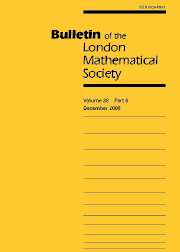Article contents
SIMPLE CLOSED GEODESICS IN HYPERBOLIC 3-MANIFOLDS
Published online by Cambridge University Press: 01 January 1999
Abstract
The question of which Riemannian manifolds admit simple closed geodesics is still a mystery. It is not known whether all closed Riemannian manifolds contain simple closed geodesics. For closed manifolds with nontrivial fundamental group, a simple closed geodesic can always be found by taking the shortest homotopically nontrivial closed geodesic. When the manifold is closed but simply connected, the question is open for dimensions three and above. In dimension two, it is known by the theorem of Lusternik and Schnirelmann [6] (see also [3] and [4]) that the 2-sphere equipped with any smooth Riemannian metric contains at least three distinct simple closed geodesics.
Non-compact manifolds do not necessarily contain closed geodesics, Euclidean space being an obvious example. Even if the manifold is not simply connected, it may not contain any simple closed geodesics, as with the hyperbolic thrice-punctured sphere. However, among the orientable, finite area, complete hyperbolic 2-manifolds, the thrice-punctured sphere is the only example that contains no simple closed geodesic. In this paper, we shall determine which orientable hyperbolic 3-manifolds do and do not contain simple closed geodesics. We shall prove that the Fuchsian group corresponding to the thrice-punctured sphere generates the only example of a complete non-elementary orientable hyperbolic 3-manifold that does not contain a simple closed geodesic. We do not assume that the manifold is geometrically finite, or even that it has finitely generated fundamental group. The simple closed geodesic which we produce arises from an interesting class of elements of the fundamental group. It is the shortest closed geodesic corresponding to a screw motion induced by the action of the fundamental group on hyperbolic 3-space.
In proving our result, we use geometric methods to obtain results about isometries of hyperbolic 3-space. These results apply to elliptic, as well as to parabolic and loxodromic isometries, and we state them in full generality.
A related question is whether a hyperbolic 3-manifold always contains a non-simple closed geodesic. In [2], Alan Reid and Ted Chinburg utilized arithmetic hyperbolic 3-manifold theory to construct examples of closed hyperbolic 3-manifolds in which every closed geodesic is simple.
We shall be working with orientable 3-manifolds, so all of the isometries discussed will be orientation preserving.
- Type
- Notes and Papers
- Information
- Copyright
- © The London Mathematical Society 1999
- 5
- Cited by


